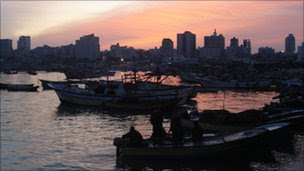The Office for Co-ordination of Humanitarian Affairs said Gazans were never informed of the exact nature of such restrictions, and the Israeli army used live ammunition to enforce them.
The policy has led to tens of thousand of people losing their livelihoods.
Israel says the restrictions are necessary to prevent militant attacks.
Palestinians are totally or partially prevented from accessing land up to 1.5km from the border
"What is foremost in our minds is protection of our civilians who live within range of the border," Israeli military spokeswoman Lt Col Avital Leibovich told the New York Times.
"If your choice is to operate terror, you have to bear the consequences."
'Dire situation'
The UN report found that over the past 10 years, the Israeli military had gradually unilaterally expanded restrictions on access to farmland on the Gaza side of the 1949 Green Line, and to fishing areas along the territory's coastline.
Since late 2008, Palestinians had been totally or partially prevented from accessing land located up to 1.5km (0.9 miles) from the border and the Mediterranean Sea beyond 5.5km (3 nautical miles) from Gaza's shore, the report said.
Overall, it was estimated by the UN that access to 17% of the total land mass of the Gaza Strip and 35% of its agricultural land was restricted.
Meanwhile, fishermen were totally prevented from accessing 85% of the maritime areas they were entitled to access according to the 1993 Oslo Accords.
An estimated 178,000 people - 12% of the population - were directly affected by the access regime implemented by the Israeli military, the report added.
The OCHA said this was primarily enforced by Israeli troops firing "warning shots" near people entering the restricted areas. However, since the end of the Israeli offensive of December 2008 and January 2009, troops had killed 22 civilians and injured 146 while doing so.
"Despite the potential for civilian casualties, the Israeli authorities have not informed the affected population about the precise boundaries of the restricted areas and the conditions under which access to these areas may be permitted or denied," OCHA said.
"Additional risks to the affected population stem from military activities of Palestinian armed factions in the restricted areas and their confrontations with the Israeli military."
The report said a complementary method used by the Israeli military to discourage access was the systematic levelling of farm land and the destruction of other private property located in restricted areas.
This, it added, had cost Gazans $308m (£197m) in the past five years and resulted in a yearly loss of approximately 75,000 tonnes of potential produce. Gaza's fishing industry was estimated to have lost $26.5m of income over the same period.
Such restrictions had also affected access to schools - seven of which are located within the restricted areas - and impeded the maintenance and upgrading of existing wastewater and electricity infrastructure, it found.
"To start addressing the dire situation of one of the most vulnerable segments of Gaza's population, the current restrictions on civilian access to Gaza's land and sea must be urgently lifted to the fullest extent possible," the OCHA urged.


No comments:
Post a Comment